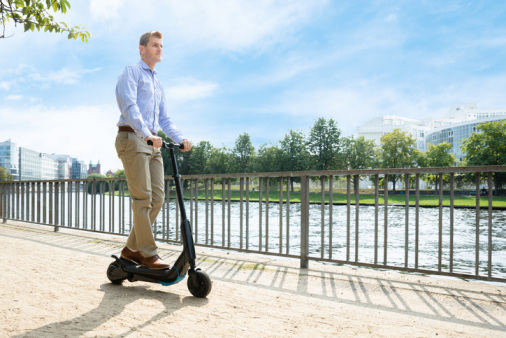E-bikes and e-scooters – what’s the fire risk?

By QBE Interim Practice Leader Adrian Simmonds
E-bikes and e-scooters are a great boon to getting around quickly and efficiently, but concern over the potential fire risk is growing.
The rise in popularity of electric bikes and electric scooters has given freedom of mobility to many people who would otherwise use cars, motorbikes, buses or be walking to their destinations.
It’s estimated that there are currently more than one million e-scooters in the UK and growing. At the same time, sales of e-bikes are on the increase, accounting for around a quarter of all bike sales in the UK. The growing demand for fuel-efficient vehicles, combined with the desire to reduce greenhouse gas and carbon emissions is helping to drive sales. By 2030, it is forecast that the global market for e-bikes will be worth $52.3 billion USD and for e-scooters $40.6 billion USD.
The delivery sector (such as food deliveries) and leisure are two of the biggest users of these ‘micro-mobility’ modes of electric transport, which also include e-skateboards, electric mopeds and motorcycles.
Fire risk
A side effect of the growth in use of these electric transport devices is a notable increase in the frequency of fires from the lithium-ion batteries used to power them. This is the same type of battery technology as used in mobile phones, tablets and laptops, all of which have been experiencing battery fires at an alarming rate compared to before lithium-ion came into common use around 2010.
So, how big is the fire risk with these micro-mobility devices? Whilst data is still quite limited, it is reported that fires have increased by 400% over the last two years. In recent months we have seen a spate of newspaper headlines from around the world and in the UK concerning fires involving e-bikes and/or e-scooters, and, tragically, a number of fatalities. The fires reported have happened mostly during battery charging, and often indoors in living rooms and bedrooms. As a result, fire brigades and local authorities around the UK are beginning to take action to apply restrictions where they have jurisdiction.
Although fires can start on the chargers, it is the fires involving the batteries themselves that are most dangerous. In normal use, lithium-ion batteries are stable and work as intended with no problems. But if one catches fire, the results can be catastrophic. The batteries on e-bikes and e-scooters are far more powerful than phone batteries so the resulting explosive fire incident tends to be significantly more energetic, causing extensive fire damage, injury and even death.
When a fire occurs on a lithium-ion battery it is the result of internal damage or faults that lead to thermal runaway in the chemicals inside the battery. This thermal runaway cannot be stopped once it starts without specialist fire suppression and containment equipment. This has resulted in many injuries where people have tried to stop the fire using standard fire extinguishers. Unless very lucky, standard fire extinguishers will not work. The thermal runaway will continue to accelerate becoming ever more explosive for several hours in the worst case.
Safe charging
Guidance for the safe charging of these personal mobility devices has been drawn up by various organisations including the UK Health and Safety Executive, fire brigades, local authorities, housing associations and insurers.
Our guidance is as follows:
- Only buy or use e-scooters, e-bikes and other micro-mobility devices from a reputable and recognised retailer that provides devices with appropriate certifications.
- If the battery suffers heavy impact or any physical damage, such as in an accident or fall, consider that it might be damaged and the fire risk increased.
- Only use the battery charger that comes with the device. Using the wrong charger or a cheap replacement charger is a major fire risk.
- Plug the charger into a power supply that has circuit breaker protection. Ideally this should have an annual inspection to verify the circuit breaker will work, however this is rarely done for domestic power supplies.
- Charging should preferably be done in a well-ventilated area outdoors and away from direct sunlight or a heat source.
- Don’t charge e-scooters, e-bikes and other micro-mobility devices indoors in a living room or bedroom or anywhere near soft furnishings and carpets.
- Don’t charge them in the common area corridors of multi-tenanted buildings as these will almost always be part of the fire escape route for some or all of the building occupants.
- If they must be charged indoors do so in a room without soft furnishings, such as a kitchen, or preferably a locked garage, shed or external cupboard that doesn’t contain the gas/electric meter or any combustibles such as BBQ gas cylinders, garden furniture or cardboard boxes.
- Make sure there is a working smoke detector in the space where devices are charging, or at least a heat detector if in a kitchen or an in-use garage.
- Don’t leave devices charging when you’re asleep or when there’s no-one is in attendance, such as when out shopping, at work or at school/college.
- Get in the habit of setting a timer/alarm to remind yourself to check on the device on charge and to unplug it when fully charged.
If a fire starts on the battery DO NOT GO NEAR IT or attempt to put the fire out. Call the Emergency Services (999 in the UK) and evacuate the premises as well as alerting neighbours if safe to do so, especially anyone living or working above you.
If used and charged safely, e-scooters, e-bikes and similar personal mobility devices are a great boon to getting around quickly and efficiently; however, the growing evidence of the fire hazards and the risks to life and property are causing a great deal of concern. If you own or use these devices, make sure you take care not to put yourself or others in unnecessary danger by misusing them or by charging them in an unsafe manner.
Risk management services for QBE customers
QBE helps businesses build resilience through risk management and insurance.
Depending upon the size and complexity of the business needs, QBE customers can access a wide range of risk management services, self-assessment questionnaires and risk management toolkits which are focused on the key causes of claims, and on generating action plans for improved outcomes - including protecting employees, reducing risk and making claims less likely. You can find out more about how QBE helps businesses to manage risk here.
Need to claim? Report it early
Finally, a reminder that if you have an incident and need to make an insurance claim, it’s important that you report it as soon as possible, ideally the same day. Reporting a claim early can save time and help you to receive any claim payments faster, as well as allowing us to help mitigate the cost of third-party claims.
Downloads
About QBE
QBE European Operations is part of QBE Insurance Group, one of the world’s leading international insurers and reinsurers and Standard & Poor’s A+ rated. Listed on the Australian Securities Exchange, QBE’s gross written premium for the year ended 31 December 2018 was US$13.7 billion.
As a business insurance specialist, QBE European Operations offers a range of insurance products from the standard suite of property, casualty and motor to the specialist financial lines, marine and energy. All are tailored to the individual needs of our small, medium and large client base.
We understand the crucial role that effective risk management plays in all organisations and work hard to understand our clients’ businesses so that we offer insurance solutions that meet their needs – from complex programmes to simpler e-trading solutions – and support them in minimising their risk exposures. Our expert risk management and rehabilitation practitioners focus on helping clients improve their risk management so that they may benefit from a reduction in claims frequency and costs.

